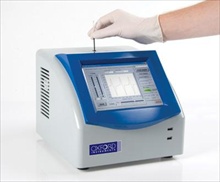Members Login

Channels
Special Offers & Promotions
Oxford Instruments Magnetic Resonance announces the release of AffirmoEX, the world's smallest footprint EMR system
publication date: Mar 13, 2012
|
author/source: Talking Science Limited
 Oxford
Instruments, the supplier of Nuclear Magnetic Resonance (NMR) solutions for QA
laboratories in the food, agricultural, healthcare, polymer, and energy
sectors, announces the launch of the AffirmoEX Electron Magnetic Resonance
(EMR) system to add to its family of benchtop instrumentation solutions.
Oxford
Instruments, the supplier of Nuclear Magnetic Resonance (NMR) solutions for QA
laboratories in the food, agricultural, healthcare, polymer, and energy
sectors, announces the launch of the AffirmoEX Electron Magnetic Resonance
(EMR) system to add to its family of benchtop instrumentation solutions. Oxford Instruments Magnetic Resonance launches an important addition to its range of benchtop instrumentation at Pittcon 2012 in Orlando. With applications in the foods sector, the AffirmoEX is a natural complement to Oxford Instruments' well-established MQC nuclear magnetic resonance systems. It will also provide the perfect solution to the academic market place where the EMR technique has become under-used due to the obsolescence of existing instrumentation, and the (until now) prohibitively high cost of buying a new instrument.
The AffirmoEX is an affordable system occupying minimal bench space, and does not require the large magnets and cooling systems needed by older style systems. It will be offered with a curriculum package for teaching professionals to bring the technique back into the laboratories of the 21st century with a modular program backed with online and written documentation.
Electron Magnetic Resonance (EMR), also known as electron paramagnetic resonance (EPR), and as electron spin resonance (ESR), was first introduced more than sixty years ago, developed simultaneously but independently in Kazan, Russia and Oxford, England. EMR measures unpaired electrons in a sample. Unpaired electrons are characteristic of free radicals and of complexes containing transition metal ions. EMR is a highly selective technique making it the first choice for free radical and transition metal oxidation state investigations. Furthermore, EMR lends itself admirably to a number of application areas. Many common reactions follow free radical chemistries. These include oxidation, free radical polymerisation and a wide range of biochemical processes. Similarly, understanding the oxidation state of inorganic transition metal complexes gives vital information to the analysis of processes such as those associated with catalysis.
Oxford Instruments' Product Marketing Manager, John Paul Cerroti, says "AffirmoEX is a perfect pairing with our existing NMR products. The technologies lie in the same field, but the applications are complementary, and bring real value to our customers both in academia and industry." Talking about the principal markets for the product, he continued "Our key markets for the AffirmoEX will initially be academia, both for teaching and research, the food industry and the transport and engineering industries. However, as EMR has such a wide range of potential applications, we expect to be discussing the value of EMR with many other industries very quickly."
For full details on hardware and software, please visit www.oxford-instruments.com
Media Partners


